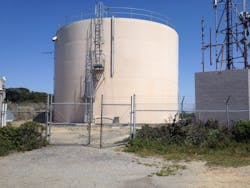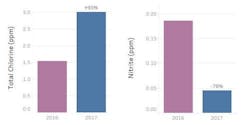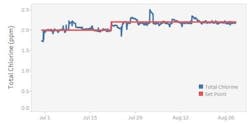Tanking Residuals
About the author:
Andy Seidel is CEO for UGSI Solutions Inc. Seidel can be reached at [email protected].
In the past decade, promulgation of the U.S. EPA’s Stage 2 Disinfectants and Disinfection Byproducts Rule has caused many water utilities and community water systems to examine their potable water disinfection processes. Water utilities that adopted the use of monochloramines as a secondary disinfectant have largely avoided the formation of disinfection byproducts in their transmission and distribution systems, but have had to adopt cumbersome and costly operational protocols to manage the frustrating chemistry that comes with using chloramines as a secondary disinfectant.
The significant challenge for operators relates to the shifting chemical equilibrium between ammonia, chlorine and chloramines in water distribution systems. The degradation of chloramine compounds can release free ammonia into distribution systems. When consumed by various types of nitrifying bacteria, this can lead to nitrification as well as taste and odor issues. The existence of nitrifying bacteria that produce nitrites and nitrates indicates that the distribution system lacks the disinfection capacity to combat pernicious forms of pathogenic growth. On the other hand, purposeful over-chlorination can quickly result in undesirable chloramine species such as dichloramine and trichloramine, which have their own unpleasant taste and odor issues.
Operational solutions consist of tank dumping, frequent tank cycling, chlorine “burns” in distribution systems and inefficient chlorine “boosting” in tanks and reservoirs. Increased utility expense due to unpredictable manpower scheduling, overtime and additional lab-work as operators struggle to meet water quality levels, particularly in warm weather months, are inevitable. Most chloramine decay occurs post-treatment plant as water ages in pipes, reservoirs and tanks. Therefore, arresting chloramine degradation in water tanks or other distribution system storage is the most efficient strategy in maintaining water quality and managing operating costs.
Over the past 10 years, automatic chloramine residual control systems (RCS) have managed the shifting chemical equilibrium along a reservoir’s disinfectant breakpoint curve to ensure that all free ammonia is reacted to provide an optimal level of monochloramine without overdosing chlorine. By combining aggressive tank mixing with smart chemical reagent addition and real-time process control, the RCS ensures that chlorine or monochloramine residual set-points are maintained without the need for constant manual operator attention. Increasingly, water utilities have turned to automatic systems to solve disinfectant residual issues.
Coppell, Texas
Located in north central Texas, the city of Coppell is part of the Dallas-Fort Worth (DFW) metroplex, an agglomeration of cities that make up the 10th most populous region in North America. Founded as a farming town by German and French immigrants in the 1830s, Coppell now is home to more than 40,000 people. While Coppell is responsible for the operations and maintenance of the water distribution and wastewater collection systems in a predominantly residential area with 16,000 connections, it relies on purchased drinking water from Dallas Water Utilities with chloramine residual in the range of 3.0 parts per million to 3.5 ppm.
Like many cities within the DFW metroplex, Coppell experienced water quality challenges at different periods throughout the year. In particular, it had difficulty maintaining adequate chloramine residuals at the 1.5-million-gal southwestern elevated storage tank during the warm summer months when outdoor watering was restricted to conserve water. The reduced demand in that area of the system meant less turnover in the storage tanks, resulting in higher water age and chloramine residual decay. Coppell experienced similar water quality problems during periods of rain, as customers curtailed their outdoor irrigation.
To combat the effects of reduced demand, the city routinely drained the storage tank and flushed the areas served by it. During the summer months, the combined draining and flushing added up to approximately 3.5 million gal of potable water per week, while the daily water demand is approximately 16 million gal per day (mgd). The seasonal flushing program required two operators to spend a half-day at least two to three times per week to maintain residual levels.
In late 2016, the city installed an RCS at its southwestern tank. The system consisted of a mechancial tank mixer, a water quality anlayzer package, a programmable logic controller, a chlorine feed skid for commercial-strength sodium hypochlorite and an ammonia feed skid for liquid ammonium sulfate (LAS). Once the equipment was installed and calibrated, a desired residual set-point was programmed into the system. The system continually monitored the existing residual in the tank and automatically adjusted the dosing rate to maintain the desired residual set point.
This created more stable residual levels and improved water quality. Data from the city shows a 95% increase in total chlorine residual from 2016 to 2017 (See Figure 1). At the same time, the data shows a 76% decrease in nitrite levels during the same time.
In the past, especially during the hot summer months, Coppell was challenged to maintain a 0.5-ppm chlorine residual. Upon start-up of the automatic RCS, the steady residual levels enabled it to practically eliminate the need for flushing, conserving large quantities of water while reducing operator man-hours that once were dedicated to these flushing exercises. Together, this contributed to making the system a cost-effective investment in a very short period of time.
“We now have more control over our water quality, which has had an effect not only in our elevated storage tank, but out in the far reaches of our distribution system,” said Jerry Davis, water operations supervisor for the city of Coppell. “We get less taste and odor complaints, have lower nitrite levels, and my operators can spend their time more productively now that we are not having to drain the tank.”
San Bruno, Calif.
Like many municipalities in urban and suburban areas, San Bruno’s source water comes both from its own groundwater supply and through a purchase agreement with a major water utility–in this case, San Francisco Public Utilities Commission (SFPUC). Also, like many municipalities in California, SFPUC, along with San Bruno, switched from free chlorine to chloramines in 2003 largely to reduce disinfection byproducts.
At first, the conversion to chloramines did not present a major challenge for San Bruno, other than having to fluctuate tank water levels to maintain proper chlorine residual. In 2010, however, San Bruno and the other 26 agencies receiving SFPUC water started experiencing issues with nitrification. San Bruno first detected low chlorine residual and high free ammonia with elevated nitrite levels in two remote tanks. Distribution operators at San Bruno quickly worked to isolate the affected pressure zones and water tanks, flushing and draining them in an attempt to restore acceptable water quality.
“September and October were especially bad,” said Mark Reinhardt, water system and conservation manager. “That’s our hottest time of year in the Bay Area. At one point, we were detecting chlorine residuals as low as 0.5 ppm, far below our action level of 1.4 ppm. The storage tanks were drained in the excess of 60,000 gal every two weeks, and we’d have to send out a crew of 4 to 5 to flush water in this entire pressure zone. It was a big maintenance burden.”
Seeking for a way to reduce the cost and manpower associated with nitrification, San Bruno’s utility managers researched technologies to lower the risk of nitrification in the water storage tanks. San Bruno managers implemented mechanical tank mixers in all the water storage tanks by the end of 2012. This helped maintain residual in tanks, but operators knew that mixing alone would not solve all the nitrification problems the utility was facing.
“Part of the problem was that we were receiving water of variable quality,” Reinhardt said. “Our goal is to maintain 2.6-ppm chlorine residual in our tanks, and we were occasionally receiving purchase water below 1.9 ppm.”
The utility needed a combination of active mixing and automated disinfectant boosting. The initial San Bruno RCS trial combined a powerful mechanical mixer with a set of water quality sensors, a pair of chemical feed systems for adding chlorine and LAS, and finally a closed-loop control system to automatically and continuously monitor and adjust chloramine disinfectant levels in a distribution system storage tank.
“The RCS acts like a thermostat on a building, setting and maintaining a constant level of residual disinfectant with the tank in continuous operation,” said Dr. Robin Giguere, who leads the PAX Water research and development team that designed the system.
The 400,000-gal Sweeney Ridge tank was selected as the site for the RCS trial. This tank is isolated by 1 mile of 14-in. pipeline and often experienced high water age, thermal stratification and elevated free ammonia levels, which left it prone to nitrification. Dumping water from the tank was particularly problematic since Sweeney Ridge is located in a protected environmental area in Golden Gate National Recreation Area. While mixing solved the thermal stratification problem, RCS was needed to correct the ammonia-to-chlorine ratio. Operators from San Bruno and engineers from PAX Water installed the system in the summer of 2013.
“The site is wonderful in some ways, with chlorine sensors already installed on site and a sweeping panoramic view of the San Francisco Bay and Pacific Ocean,” Giguere said. “Unfortunately, the weather conditions can go from beautiful and sunny to 50-mph winds, fog and large temperature drops in a matter of minutes. So it ended up being an extreme test for the environmental performance of our system.”
The average free ammonia level when the RCS was off was 0.14 ppm, whereas when the RCS was in operation, free ammonia levels averaged less than 0.02 ppm, the detection limit for the method used. Lab samples confirmed that the RCS maintained ideal monochloramine chemistry. The results showed San Bruno operators that the RCS could reliably eliminate excess ammonia while maintaining consistent monochloramine chemistry.
“Right away, we saw chlorine residual levels improve in our Sweeney Ridge tank, and our nitrification problem went away,” Reinhardt said.
Prior to turning on the system, total chlorine levels in the tank averaged around 1.5 ppm. Operators chose an initial set point of 2.0 ppm total chlorine and turned on the RCS. Within the first 24 hours, the RCS added chlorine and ammonia and continuously monitored water chemistry until the 2.0 ppm set point was reached (See Figure 3). For the following three weeks, the RCS held the 2.0 ppm set point as the tank was filled and drained. In late July, operators bumped the set point up to 2.2 ppm; the RCS quickly established this new level and held it through the summer.
Following completion of this trial phase, San Bruno moved forward with the permanent installation of an RCS at Sweeney Ridge and implementation of RCSs at two additional tanks in its system: the reconstruction of the 2-mgd Glenview tank and tank No. 4.
“With the combination of active mixing in all our tanks and RCS, we’re one of the only municipalities in the area to keep our tanks three-quarters full and maintain good residual levels,” Reinhardt said. “With the addition of another two RCS systems, I expect to keep my tanks completely full, with steady residual, no nitrification and year-round fire protection.”



